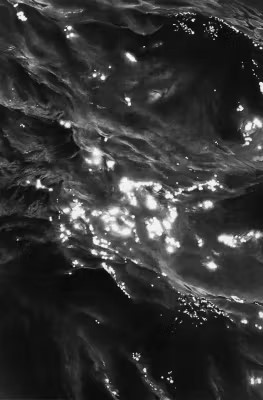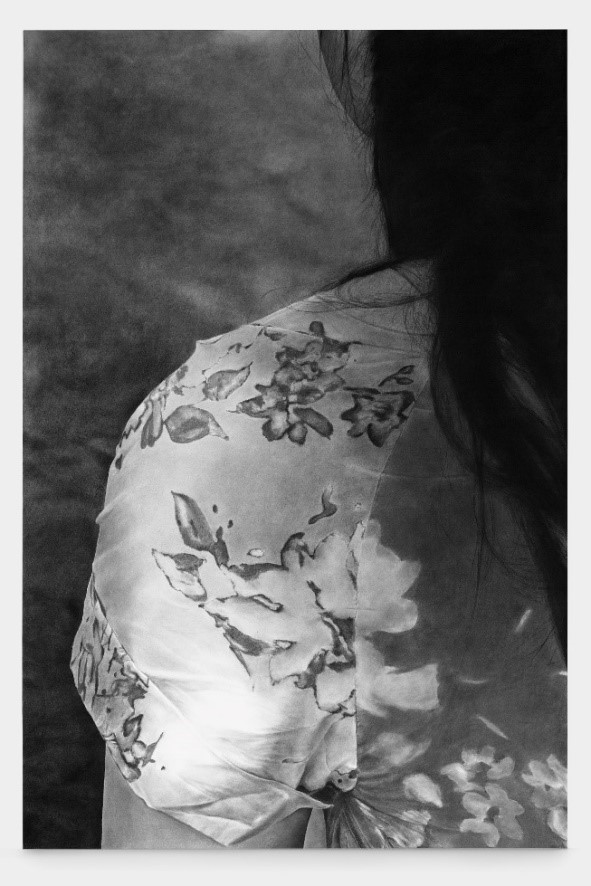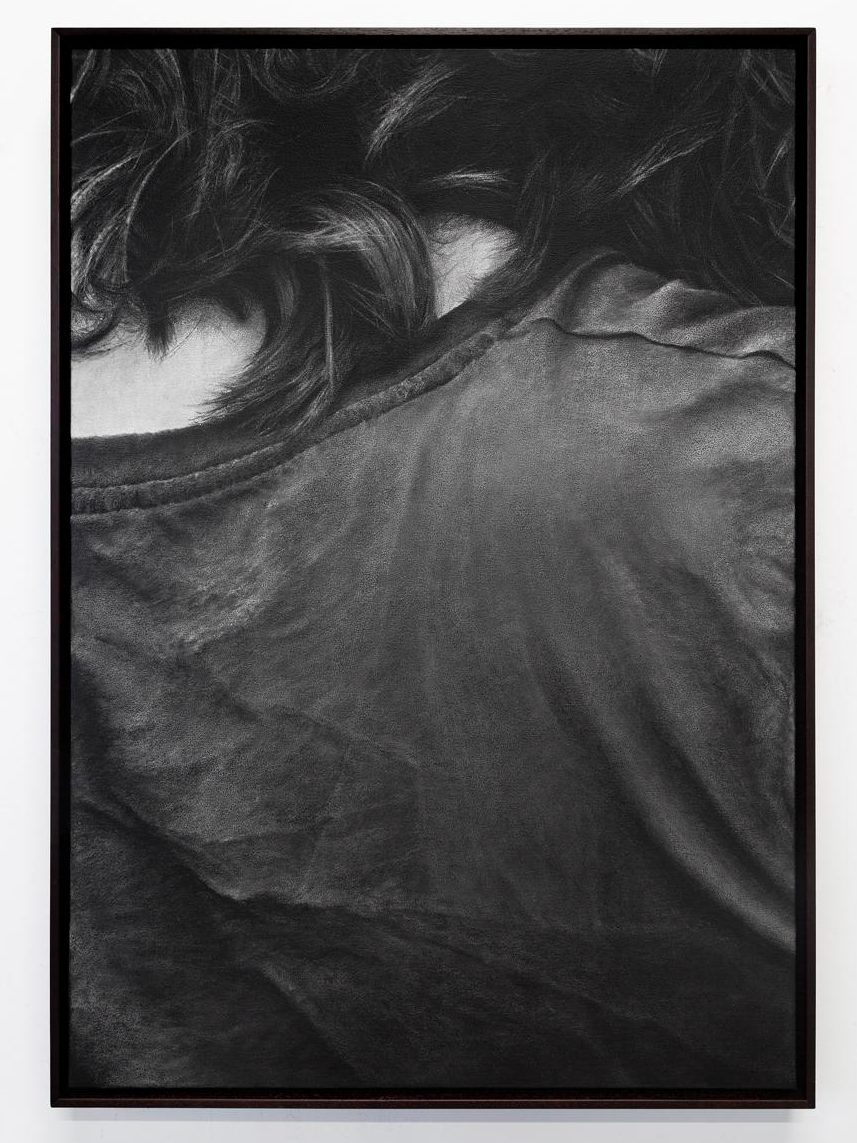Artist Spotlight: Alexandre Zhu
Paris-based Chinese artist Alexandre Zhu (b. 1993) creates strikingly hyper-realistic works using only charcoal, gesso and varnish. His large-scale compositions are imbued with depth and texture, achieving an almost sculptural presence despite their two-dimensional form. Recently, Zhu’s atmospheric seascapes and introspective portraits have garnered attention, with exhibitions at Paris Internationale, NADA Paris, Victoria Miro in Venice, and Art Basel Hong Kong—signalling his growing recognition and market potential.
One chilly February afternoon, Advisory Coordinator Margaret Rand had the pleasure of speaking with Zhu over Zoom to discuss his practice and upcoming exhibitions.
Spending his childhood between Shanghai and Paris, Zhu initially became drawn to charcoal during his first year of art school at École Nationale Supérieure des Arts Décoratifs (ENSAD) in Paris. Drawn to its tactile nature, describing the charcoal as “simply dust,” Zhu developed his distinctive technique—sanding layers of handmade gesso to create the ideal ground before applying his charcoal and varnishing the surface for a velvety texture.
These monochrome compositions feature imagery from his personal memories or photos, cropped to emphasize the soft curvature of machinery, the glimmering crests of waves, or the delicate wrinkles in his loved ones’ clothing. These enlarged forms envelope the artist as he works, challenging his perception and understanding of form to such an extent he must “rest [his] eyes every fifteen to twenty minutes.” Employing unconventional materials such as makeup sponges and bubble wrap, Zhu shifts and moulds the “dust” to conjure his nostalgic, ashy memories that reveal few—if any—traces of hand or gesture.
Zhu’s early charcoal series started around a specific narrative, capturing Shanghai’s changing environment where he grew up. His first series Leviathan (2022) features close-up images of the machinery tied to construction sites. These works root themselves in Zhu’s personal history, traveling frequently between Paris and Shanghai, and witnessing the fast-paced urban transformation of China. In our interview, Zhu revealed how he “wouldn’t recognize the places [he] once knew,” infatuated by the rapid reinvention of his hometown. This investigation into China’s urbanisation is a prevalent theme throughout Chinese art over the past several years, similarly investigated by notable contemporaries like Liu Wei, Ding Yi and Zhang Ruyi. By enlarging and cropping this machinery, Zhu isolates the ambiguous fragments, often fleeting and overlooked, within the greater process of building. Stripped away from any recognizable function and detached from any specific context, this raw imagery of metal and steel relies on feeling, rather than clear representation, to invoke meaning.
The soft dust particles and subtle shifts in grey tones are accentuated by the artist’s intentional use of a limited black-and-white palette, intended to create distance between the artist and the work. To Zhu, “colour means choosing, sometimes emotions.” By deliberately limiting his palette, the artist leaves the power in the viewer’s unique experience of the work. This deliberate limitation in colour and form, along with his photorealistic style, reflect Zhu’s broader artistic approach, focusing on the raw impact of his composition.
While investigating Zhu’s work, I noticed that most of his series are named after mythological creatures or gods. His Leviathan series is named after the primordial sea serpent from ancient mythology, known to symbolize world destruction, alongside reconstruction and renewal. This duality mirrors the rapid transformation Zhu observes in his own city, a process of continuous upheaval and rebirth. It is this very duality that Zhu evokes in his fragmented images. By isolating and obscuring parts of machinery by focusing on extreme close-ups, he seeks to recapture their forms as if they were alive— “sometimes tender, sometimes aggressive”—evoking the shifting, dynamic essence of these objects in the context of change.
This dualism is further seen in Zhu’s later series of seascapes. The artist’s 2024 Hadal Series is named after the Greek god of the dead and king of the underworld Hades. Here, Zhu continues to capture the core sentiments of the changing world around him within these seemingly “neutral images.” These seascapes serve as a larger metaphor for the simultaneous beauty and ominous quality of the ocean. His velvet-like surfaces soak up the viewer into their lush, glistening waves, while the deep black charcoal overwhelms, perhaps akin to the overpowering radiance of Yves Klein’s Blue. According to Zhu, “the closed and tight cropping is meant to remove information and context, evoking [his] gaze of a fleeting moment and trying to leave the viewer in his own perception of a personal memory, through [his] own.” Similar to the machinery in Zhu’s Leviathan Series, these seascapes deliberately lack any time zones or specific contexts. Rather, they are driven by the all-encompassing textural elements of each body of water, captured in the large-scale composition.

In his most recent works, Zhu has transitioned toward more personal subject matter, focusing on intimate portrayals of his loved ones from behind. This unique perspective builds on the artist’s Leviathan and Hadal series, honing into detailed fragments of his subjects. This new body of work was first exhibited at the Paris Internationale fair, concurrent with Art Basel Paris Plus, with Shanghai-based Vacancy Gallery. The titular work Ma (2024) is a close-up of the artist’s mother, featuring solely her left shoulder and part of her hair. Her blouse’s floral design folds in rhythm with the fabric’s wrinkles and bulges, while delicate strands of hair sweep down, framing the upper right section of the canvas. Zhu became tired of working in series and felt a strong need to tap into more personal subject matter as he began to work on multiple, different images at the same time, blending intimate portraits alongside his urban and natural landscapes. It is here that Zhu has begun to turn back to more narrative compositions, revisiting personal memories based on images of loved ones to accompany his charcoal environments. As such, simultaneously on display to his new series at Paris Internationale were Zhu’s seminal seascapes at NADA Paris with London-based Night Café Gallery.
Another piece from this new body of work, They’ll never know (2) (2025) is currently on view in Vacancy’s booth at Art Basel Hong Kong. Here, Zhu continues to play with the relationship between title and composition, capturing the balance between intimacy and anonymity. The title They’ll never know adds an emotional weight to the work, hinting at the unspoken moments and unshared connections that exist behind closed doors. The blurred details of the figure, combined with Zhu’s meticulous charcoal technique, evoke a sense of longing and memory, inviting viewers to project their own experiences onto the ambiguous scene. This exploration of private moments against the backdrop of Zhu’s signature charcoal landscapes marks a poignant evolution in his work, as he moves away from abstract forms and towards a more direct, emotional connection with his subjects.
Zhu’s transition away from rigid series and toward more varied compositions suggests a maturing artistic vision, one that is both timeless in his investigations and innovative in his unconventional materiality. With continued exposure at key fairs and galleries, we are eager to see how Zhu’s artistic practice will continue to develop.

Paris Internationale 2024

Art Basel Hong Kong 2025


